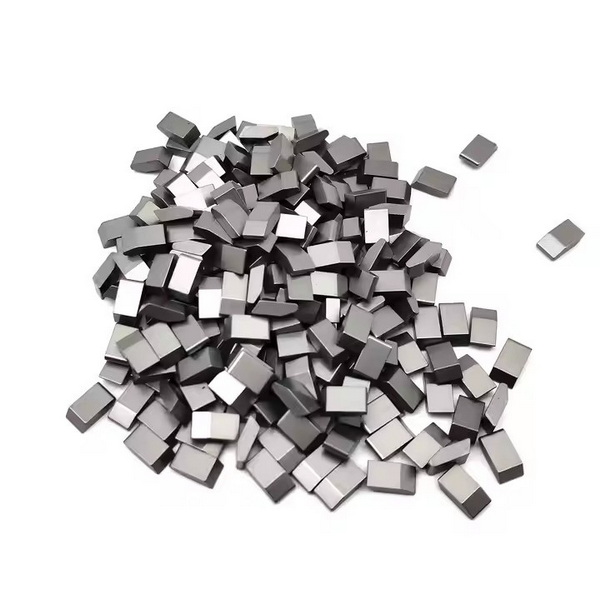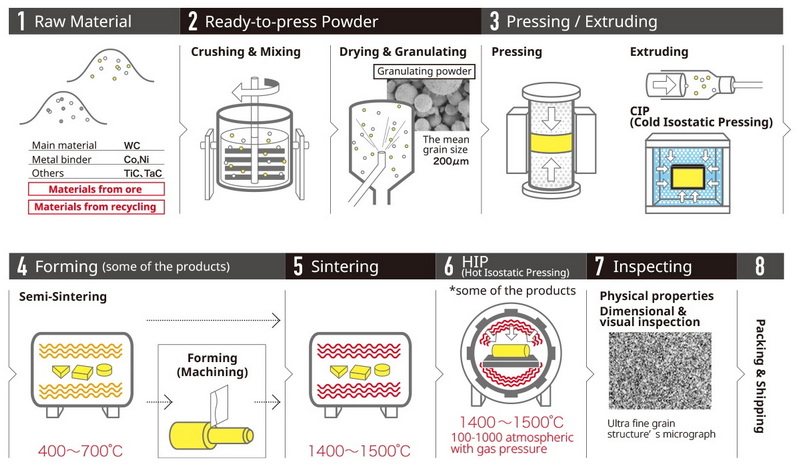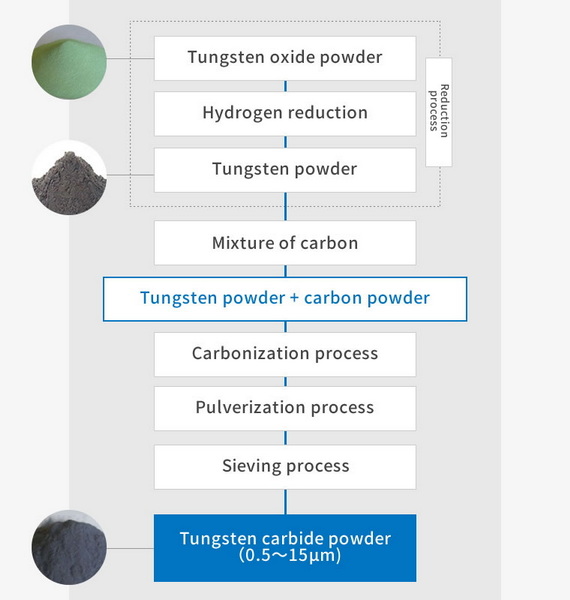Content Menu
● Tungsten Carbide Composition
● Uses for Tungsten Carbide
● The Manufacturing of Tungsten Carbide
● Heat Treatment
>> Quenching and Tempering
>> Optimizing Heat Treatment for Tungsten Carbide
>> Advanced Techniques in Heat Treatment
● Applications Benefiting from Optimized Heat Treatment
● Conclusion
● FAQ
>> 1. What is quenching?
>> 2. Why is tempering necessary after quenching?
>> 3. What are the primary stages of tungsten carbide heat treatment?
>> 4. How does tungsten carbide compare to steel in cutting tool applications?
>> 5. What makes tungsten carbide suitable for ammunition?
● Citations:
Tungsten carbide is a compound of tungsten and carbon. Its hardness is similar to that of a diamond, and it possesses excellent physical and chemical properties that make it suitable for a wide array of applications. It is a good conductor of electricity and heat. Pure tungsten carbide is fragile, but adding metals like titanium and cobalt can reduce brittleness.
Tungsten carbide is a popular material in many industries, including tooling, construction, and medicine. Tungsten carbide is commonly used in construction materials like drill bits and saws because it is nearly unbreakable. In medicine, tungsten carbide enhances the performance of surgical instruments and makes them corrosion-resistant.

Tungsten Carbide Composition
Tungsten carbide consists of tungsten and carbon, with the chemical formula WC and a molecular weight of 195.85. The microhardness of tungsten carbide is 17300 MPa, its elastic modulus is 710GPa, and its compressive strength is 56MP. The coefficient of thermal expansion is 6.9 × 10-6 / K.
Uses for Tungsten Carbide
Tungsten carbide has many uses, including:
- Cutting tools
- High-speed cutting turning tools
- Kiln furnace structural materials
- Jet engine components
- Cermet materials
- Resistance heating elements
- Wear-resistant parts
- Smelting crucibles
- Wear-resistant semiconductor films
- Aerospace materials
- Mining
- Ammunition
- Surgical instruments
- Jewelry
The Manufacturing of Tungsten Carbide
Tungsten carbide exists in powder form and is given different shapes through a sintering process. Tungsten anhydride (WO3) and graphite can synthesize tungsten carbide (WC) powder in a reducing atmosphere at a high temperature of 1400-1600 °C. Then, dense ceramic products can be made through hot pressing sintering or hot isostatic pressing sintering.
Heat Treatment
Heat treatment can improve the physical and mechanical characteristics of tungsten carbide. The heat treatment process has a significant effect on the mechanical properties of tungsten carbide. The heat treatment process of tungsten carbide has four main stages:
1. Removal of molding material and pre-sintering At the start of sintering, the forming agent decomposes or evaporates, thereby excluding the sintered body. At the same time, the forming agents carburize the sintering, and the amount of carbon will vary depending on the type, amount, and process of sintering. Powder surface oxide reduces, and hydrogen can reduce cobalt and tungsten oxides at the sintering temperature. With a weak reaction between carbon and oxygen, the contact stress between the powder particles is gradually removed. The bonding metal powder starts to respond, and recrystallization and surface diffusion begin to occur. Block strength increases.
2. Stage of solid-phase sintering (800°C - eutectic temperature) In the presence of a liquid phase, solid-phase reactions and diffusion are aggravated with an increase in plastic flow, and a clear shrinkage appears in the sintered body.
3. Stage of liquid-phase sintering (eutectic temperature - sintering temperature) When the liquid phase of the sintered body occurs, the compression is quickly completed, and then a crystallization transition occurs. The basic organization and structure of the carbide are formed.
4. Cooling stage (sintering temperature - room temperature) At this stage, the organizational and phase components of tungsten carbide undergo certain changes under various cooling conditions.
Quenching and Tempering
Quenching and tempering are key parts of the heat treatment process. They further improve the toughness and strength of parts through a combination of quenching and high-temperature tempering. This process requires precise control of heating temperatures, cooling rates, and tempering temperatures, as well as a deep understanding of the material's microstructure and properties.
Quenching is the first and most critical step in the quenching and tempering process. By heating the steel to the austenite zone, the carbon and alloy elements inside the steel fully dissolve in the austenite to form a uniform solid solution. Subsequently, the steel is quickly cooled to the martensite zone, causing the austenite to undergo martensite transformation, thereby obtaining a high-hardness structure. The cooling rate must be fast enough to avoid other transformations of austenite during the cooling process, which would reduce hardness. For super-hard solid tungsten carbide boring bars, quenching treatment can significantly increase its hardness and enhance its resistance to wear and deformation. However, the quenching stress generated during the quenching process cannot be ignored. If these stresses are not effectively eliminated, defects such as cracks and deformation will occur during use, thus affecting their service life and performance.
High-temperature tempering is an indispensable step in the quenching and tempering process to solve the problems caused by quenching stress. High-temperature tempering heats the steel to a certain temperature (usually higher than the austenite transformation temperature but lower than the melting point of the material) after quenching and maintains it for a period of time to release and eliminate the residual stress inside the steel. At the same time, high-temperature tempering can promote the precipitation and uniform distribution of carbides, further improving the toughness and strength of steel.
Optimizing Heat Treatment for Tungsten Carbide
Optimizing the heat treatment process of tungsten carbide involves carefully controlling several factors to achieve the desired material properties. These factors include heating rate, soaking time, cooling rate, and the atmosphere within the furnace.
- Heating Rate: The rate at which tungsten carbide is heated is critical to prevent thermal shock and ensure uniform temperature distribution. Slow heating rates are preferred, especially during the initial stages, to avoid cracking or distortion of the material.
- Soaking Time: Soaking time refers to the duration the material is held at a specific temperature. Adequate soaking time is essential for ensuring that the tungsten carbide reaches a uniform temperature throughout its structure, allowing for complete phase transformations and stress relief.
- Cooling Rate: The cooling rate after heat treatment significantly affects the microstructure and hardness of tungsten carbide. Rapid cooling, such as quenching in oil or water, can produce a harder but more brittle material. Slower cooling rates, like air cooling or furnace cooling, result in a tougher but less hard material.
- Atmosphere Control: The atmosphere within the heat treatment furnace plays a crucial role in preventing oxidation and decarburization of tungsten carbide. Inert atmospheres, such as argon or nitrogen, are commonly used to protect the material from reacting with oxygen and carbon, thus maintaining its desired composition and properties.
Advanced Techniques in Heat Treatment
Advanced heat treatment techniques are increasingly being employed to further enhance the properties of tungsten carbide. These techniques include vacuum heat treatment, gas carburizing, and cryogenic treatment.
- Vacuum Heat Treatment: Vacuum heat treatment involves heating the material in a vacuum environment, which eliminates oxidation and allows for precise control of the heating and cooling rates. This technique results in a cleaner, brighter surface finish and improved mechanical properties.
- Gas Carburizing: Gas carburizing is a process in which the surface of tungsten carbide is enriched with carbon atoms. This is achieved by heating the material in a carbon-rich atmosphere, typically using gases like methane or propane. Gas carburizing increases the surface hardness and wear resistance of tungsten carbide, making it suitable for applications requiring high surface durability.
- Cryogenic Treatment: Cryogenic treatment involves cooling tungsten carbide to extremely low temperatures, typically below -150°C. This process can improve the material's hardness, wear resistance, and dimensional stability by promoting the transformation of retained austenite into martensite and refining the microstructure.

Applications Benefiting from Optimized Heat Treatment
Optimized heat treatment significantly enhances the performance and lifespan of tungsten carbide in various applications. Here are some notable examples:
- Cutting Tools: In the machining industry, tungsten carbide cutting tools are widely used due to their high hardness and wear resistance. Optimized heat treatment improves the tool's ability to maintain a sharp cutting edge, reduce wear, and withstand high cutting speeds and feeds.
- Wear Parts: Components subjected to heavy wear, such as dies, molds, and bearings, benefit from the enhanced surface hardness and wear resistance achieved through optimized heat treatment. This extends the service life of these parts and reduces the frequency of replacements.
- Mining and Drilling Tools: In the mining and drilling industries, tungsten carbide is used in drill bits, nozzles, and other components that experience severe abrasive conditions. Optimized heat treatment ensures that these tools can withstand the harsh environments and maintain their performance over extended periods.
- Aerospace Components: Tungsten carbide is used in aerospace applications for its high strength-to-weight ratio and ability to withstand extreme temperatures. Optimized heat treatment enhances the material's mechanical properties and thermal stability, making it suitable for use in critical aerospace components.
- Medical Instruments: Tungsten carbide is also used in surgical instruments and medical devices due to its biocompatibility and resistance to corrosion. Optimized heat treatment ensures that these instruments maintain their sharpness, durability, and hygiene, contributing to improved surgical outcomes.
Conclusion
Tungsten carbide is a very hard and durable material suited for a wide range of applications. It is created by combining tungsten and carbon and can be enhanced by adding other metals like titanium and cobalt. Heat treatments, such as quenching and tempering, are important for maximizing the performance of tungsten carbide in demanding applications. Optimizing heat treatment processes through precise control of heating rates, soaking times, cooling rates, and atmospheric conditions can significantly enhance the mechanical properties, wear resistance, and overall performance of tungsten carbide. Advanced techniques such as vacuum heat treatment, gas carburizing, and cryogenic treatment further refine these properties, making tungsten carbide an indispensable material in industries ranging from machining and mining to aerospace and medicine.

FAQ
1. What is quenching?
Quenching is the rapid cooling of a material to harden it. For steel, it involves heating the material to the austenite zone, then quickly cooling it to transform the austenite into martensite, a very hard structure. This process is crucial for increasing the hardness and wear resistance of tungsten carbide boring bars.
2. Why is tempering necessary after quenching?
Tempering is necessary to relieve the internal stresses that develop during quenching. High-temperature tempering heats the steel to a specific temperature below its melting point to release residual stress and prevent defects like cracks. This also promotes the precipitation of carbides, enhancing the toughness and strength of the material.
3. What are the primary stages of tungsten carbide heat treatment?
The primary stages include removing molding material and pre-sintering, solid-phase sintering, liquid-phase sintering, and cooling. Each stage involves specific temperature ranges and processes to refine the material's properties.
4. How does tungsten carbide compare to steel in cutting tool applications?
Tungsten carbide cutting tools are more abrasion-resistant and can withstand higher temperatures than standard high-speed steel (HSS) tools. Carbide tools maintain a sharp cutting edge longer, produce better finishes, and allow for faster machining.
5. What makes tungsten carbide suitable for ammunition?
Tungsten carbide's combination of great hardness and high density makes it effective in armor-piercing ammunition. It is often used in monolithic sintered form or as a cemented composite with cobalt.
Citations:
[1] https://www.linkedin.com/pulse/four-main-stages-tungsten-carbide-heat-treatment-shijin-lei
[2] https://www.refractorymetal.org/tungsten-carbide-uses-properties.html
[3] https://www.chaitools.com/news/industry-news/how-to-make-superhard-solid-tungsten-carbide-boring-bars-have-both-hardness-and-toughness-through-quenching-and-tempering-treatment.html
[4] https://www.tungco.com/insights/blog/5-tungsten-carbide-applications/
[5] https://patents.google.com/patent/US4008090A/en
[6] https://www.sollex.se/en/blog/post/about-cemented-tungsten-carbide-applications-part-1
[7] https://www.ijera.com/papers/vol12no11/1211200204.pdf
[8] https://en.wikipedia.org/wiki/Tungsten_carbide
[9] https://eurobalt.net/blog/2022/03/28/all-the-applications-of-tungsten-carbide/
















